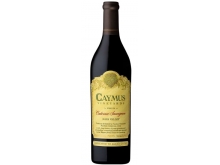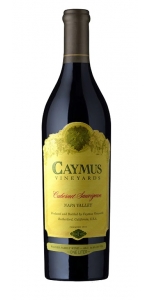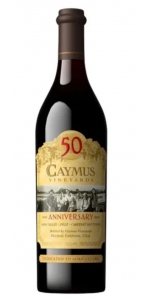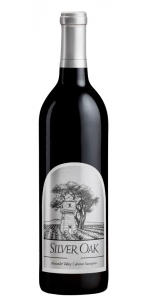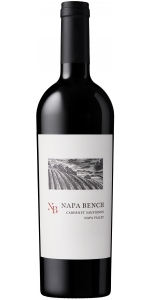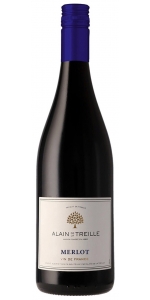Les Cailloux Blanc displays a pale gold color in its youth and evolves into deep gold after a few years of aging. It has floral scents of honeysuckle and jasmine with hints of honey. On the palate, white flowers and honey are joined by minerality and viscosity on the finish. The wine’s surprising complexity grows more well-rounded as it evolves in the glass.
Caymus Napa Valley Cabernet Sauvignon 2020
| Country: | United States |
| Regions: | California California (Napa) |
| Winery: | Caymus |
| Grape Type: | Cabernet Sauvignon |
| Organic: | Yes |
| Vintage: | 2020 |
| Bottle Size: | 750 ml |
Caymus has a signature style that is dark in color, with rich fruit and ripe, velvety tannins – as approachable in youth as in maturity. We farm Cabernet grapes in eight of Napa’s 16 sub-appellations, with diversification enabling us to make the best possible wine in a given year. This Cabernet offers layered, lush aromas and flavors, including cocoa, cassis and ripe dark berries.
Mark your calendars for June! Caymus 50th Anniversary Napa Valley Cabernet Sauvignon 2022 is a testament to fifty years of exceptional winemaking by the dedicated, passionate, and family-owned Caymus Vineyards. Since 1972, they have remained a beacon of excellence in Napa Valley, staying true to their roots and producing unparalleled Cabernet Sauvignon. This limited edition wine is a celebration of their rich history, tradition, and relentless pursuit of quality across generations.
Mark your calendars for June! Caymus 50th Anniversary Napa Valley Cabernet Sauvignon 2022 is a testament to fifty years of exceptional winemaking by the dedicated, passionate, and family-owned Caymus Vineyards. Since 1972, they have remained a beacon of excellence in Napa Valley, staying true to their roots and producing unparalleled Cabernet Sauvignon. This limited edition wine is a celebration of their rich history, tradition, and relentless pursuit of quality across generations.
Lexicon Cabernet Sauvignon Napa Valley is made from 100 percent Cabernet Sauvignon.
Lexicon varietal wines are carefully selected by Fran Kysela to show the essence of each variety, along with its terroir of origin, both of which are essential elements of a good wine.
Lexicon Cabernet Sauvignon offers rich and concentrated fruit aromas of red and black currant, cassis and black cherry along with black pepper and dried herb accents. It is soft and generous in the mouth, intense and complex, with supple tannins and elegant structure.
Pair with: Grilled meat, ribeye steak, filet mignon, roasted lamb with fresh herbs, cheesburger, semi-hard cheeses, truffled brie, portobello mushrooms.
Silver Oak Alexander Valley Cabernet Sauvignon is made from 95.2% Cabernet Sauvignon, 2.5% Cabernet Franc, 1.9% Merlot, 0.4% Petit Verdot
The Silver Oak Alexander Valley Cabernet Sauvignon 2019 has notes of red cherry, raspberry, blackberry, iris, vanilla and clove. Ruby in color, this elegant wine has great acidity and lift on the mid-palate. Black currant and warm baking spices linger with a deep and fruity finish. It will provide drinking pleasure through 2047 given proper cellaring.
Review:
Plush and sexy, Silver Oak’s dazzling 2020 Alexander Valley Cabernet Sauvignon delivers succulent dark fruit offset by black olive-like nuances. Polished and suave tannins provide support without being intrusive or distracting, allowing for immediate enjoyment with a steak. Good acidity keeps it bright and you coming back for another sip.---- Michael Apstein
- Wine Review Online 93 Points
Napa Bench Cabernet Sauvigon Napa Valley is made from 95% Cabernet Sauvignon, 3% Merlot, 2% Petite Verdot.
The wine is aged in French oak barrels for 16 months.
The Bench lands of Napa Valley are where we find Cabernet Sauvignon with Power and Strength. Elegant and supple tannins complete the structure. Bench lands are the geological middle ground that connect the Valley Floor with the Mountain rises, perfectly drained soils!
NAPA BENCH Cabernet Sauvignon is a sophisticated blend of Napa Valley Cabernet Sauvignon. We start with Cabernet Sauvignon 95%, blend Merlot 3%, and finish with Petite Verdot 2%. The wine is aged in French oak barrels for 16 months.
Tasting Notes
NAPA BENCH is rich and flavorful. Red and dark fruits are apparent in the nose with Plum, Currant and Blackberry tones. The aroma is layered and shows the power of Cabernet and of oak nuance. The pallet is fine grained tannin, long and refined with a high degree of Deliciosity! The finish lingers and invites a second glass. Share with your favorite friends, and always with your hottest date.
Caymus has a signature style that is dark in color, with rich fruit and ripe, velvety tannins – as approachable in youth as in maturity. We farm Cabernet grapes in eight of Napa’s 16 sub-appellations, with diversification enabling us to make the best possible wine in a given year. This Cabernet offers layered, lush aromas and flavors, including cocoa, cassis and ripe dark berries.
In 1971 Charles F. (Charlie) Wagner and his wife Lorna Belle Glos Wagner asked their son Charles J. (Chuck) Wagner, who had just graduated from high school, if he would be interested in joining them in starting up a winery. If Chuck declined the offer, Charlie and Lorna were planning to sell out of their ranch in Napa Valley and move to Australia. Chuck accepted his parents’ offer to launch the winery, Caymus Vineyards.
The Wagners produced their first vintage in 1972, consisting of 240 cases of Cabernet Sauvignon. Since then, Caymus has focused their efforts in the production of quality Cabernet Sauvignon. Today’s production is 65,000 cases.
Caymus Vineyards remains 100% family-owned by the Wagners. Charlie, Lorna Belle, and Chuck worked together as a remarkable team for over 30 years building Caymus Cabernet. Today, Chuck, his two sons, Charlie and Joe, and one daughter, Jenny, have joined the family team. Farming grapes remain the priority with the family farming about 350 acres of choice Napa Valley land.
The Wagners took the name Caymus from the Mexican land grant known as Rancho Caymus, given to George Yount in 1836, which encompassed what eventually became the town of Rutherford and much of the surrounding area.
Alain de la Treille Merlot is made from 100 percent Merlot.
This Merlot has a deep red color. On the nose aromas of red fruits with a herbal note and spicy scents.
Lexicon Cabernet Sauvignon Napa Valley is made from 100 percent Cabernet Sauvignon.
Lexicon varietal wines are carefully selected by Fran Kysela to show the essence of each variety, along with its terroir of origin, both of which are essential elements of a good wine.
Lexicon Cabernet Sauvignon offers rich and concentrated fruit aromas of red and black currant, cassis and black cherry along with black pepper and dried herb accents. It is soft and generous in the mouth, intense and complex, with supple tannins and elegant structure.
Pair with: Grilled meat, ribeye steak, filet mignon, roasted lamb with fresh herbs, cheesburger, semi-hard cheeses, truffled brie, portobello mushrooms.
- back
Dark plum in color with abundant aromas of dark chocolate, black cherry, and sun-ripened blackberry with a hint of cedar. Layered flavors of blackberry and raspberry pie filling, accompanied by notes of cinnamon, chocolate, and nutmeg play on the palate. Smooth and focused with refined tannins and a medium finish.
Review:
-Wine Enthusiast 94 Points
-Tasting Panel 94 Points
Lucien et Andre Brunel Chateauneuf-du-Pape Les Cailloux Blanc is made from 70% Roussanne, 20% Grenache Blanc, 10% Clairette.
This historic estate was established in the 17th century when André Brunel’s family purchased a vineyard plot from the Bishop of Avignon. André took over the reins of this estate in 1971, and later his son Fabrice joined the winemaking team in 2012, keeping the family legacy alive by pursuing quality with the highest regard and respect for the environment.
Châteauneuf-du-Pape is notorious for its large, round pebbles that absorb the sun’s energy, radiating warmth throughout the night, allowing the grapes to achieve ideal ripeness and incredible complexity. “Les Cailloux” gets its name from the pebbles.
Review:
Inviting aromas of grapefruit and lime zest, Meyer lemon and honeydew harmonize with wild white flowers and stone on the nose. The palate is refreshed by brisk acidity, making way for a wave of fresh pears lemon zest, subtly framed by a layer of stone and light oak spice.
-Wine Enthusiast 96 Points

